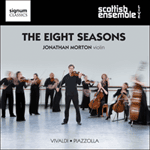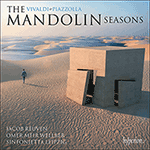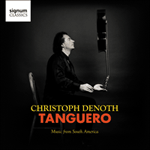
Welcome to Hyperion Records, a British classical label devoted to presenting high-quality recordings of music of all styles and from all periods from the twelfth century to the twenty-first.
Hyperion offers both CDs, and downloads in a number of formats. The site is also available in several languages.
Please use the dropdown buttons to set your preferred options, or use the checkbox to accept the defaults.

An earlier concert by Quinteto Nuevo Tango at New York’s Philharmonic Hall on 26 May 1965 was reviewed perceptively by Robert Shelton in The New York Times; he described that ‘sometimes the quintet sounded like a 1920-ish ballroom dance band, then like a Chico Hamilton/Fred Katz modern jazz combo, then it suggested a classical quintet turning from chamber music to bossa nova’. Five years after the composer’s death, The New York Times published an astute appraisal (16 January 1997) by critic Jon Pareles:
[Piazzolla] was Argentina’s equivalent of Gershwin or Ellington. His compositions carry the tango to the concert stage, using the sultry melodies and the insinuating pulse of the tango as a basis for the fantasias and fugues laced with twentieth-century dissonances. In many of Piazzolla’s works a restless, craggy first theme gives way to a yearning second one; the music starts out imperious, then reveals its tender heart.
from notes by David Vickers © 2022
Un concert antérieur du Quinteto Nuevo Tango au Philharmonic Hall de New York le 26 mai 1965 fit l’objet d’une critique pertinente de Robert Shelton dans The New York Times, soulignant que «parfois le quintet sonnait comme un orchestre de danse de salle de bal des années 1920, puis comme un combo de jazz moderne de Chico Hamilton/Fred Katz pour faire ensuite penser à un quintette classique passant de la musique de chambre à la bossa nova». Cinq ans après la mort du compositeur, The New York Times publia une appréciation perspicace (16 janvier 1997) du critique Jon Pareles:
[Piazzolla] était l’équivalent argentin de Gershwin ou Ellington. Ses compositions portent le tango sur la scène de concert, en utilisant les mélodies sensuelles et la pulsation pleine de sous-entendus du tango comme base de fantaisies et fugues mêlées de dissonances du XXe siècle. Dans beaucoup d’œuvres de Piazzolla, un premier thème agité et taillé à la serpe fait place à un second thème plein de tendresse; la musique démarre impérieuse, puis révèle son cœur tendre.
extrait des notes rédigées par David Vickers © 2022
Français: Marie-Stella Pâris
Ein früher Auftritt des Quinteto Nuevo Tango in der New Yorker Philharmonic Hall am 26. Mai 1965 erfuhr in der New York Times eine hellhörige Kritik von Robert Shelton: „Manchmal klang das Quintett wie eine Tanzkapelle der Zwanzigerjahre, dann wie eine Chico-Hamilton/Fred-Katz-Jazz-Combo; dann wieder wirkte es wie ein klassisches Quintett, das von Kammermmusik zu Bossa nova umschaltet.“ Fünf Jahre nach dem Tod des Komponisten erschien in der New York Times eine scharfsinnige Darstellung des Kritikers Jon Pareles:
[Piazzolla] war die argentinische Entsprechung eines Gershwin oder Ellington. Seine Kompositionen bringen den Tango in den Konzertsaal, sie benutzen die sinnlichen Melodien und den anspielungsreichen Rhythmus des Tango als Grundlage für Fantasien und Fugen, gewürzt mit den Dissonanzen des 20. Jahrhunderts. In vielen von Piazzollas Werken macht ein ruheloses, schroffes erstes einem sehnsüchtigen zweiten Thema Platz; die Musik beginnt herrisch und offenbart dann ihr empfindsames Herz.
aus dem Begleittext von David Vickers © 2022
Deutsch: Friedrich Sprondel
 Vivaldi & Piazzolla: The Eight Seasons Vivaldi & Piazzolla: The Eight SeasonsCombining Vivaldi's timeless Four Seasons with Piazzolla's tango-inspired The Four Seasons of Buenos Aires, this is a unique album from one of Scotland's most dynamic and versatile groups, the Scottish Ensemble, performing under dynamic Artistic D ...» More |
 Vivaldi & Piazzolla: The mandolin seasons Vivaldi & Piazzolla: The mandolin seasonsA mandolin for all seasons—Vivaldi and Piazzolla as you’ve never heard them before.» More |
 Tanguero TangueroThe guitar is something of the national instrument of South America—this selection brings together many of the styles and genres of that vast continent in a colourful blend of melodies, rhythms, and harmonies.» More |

